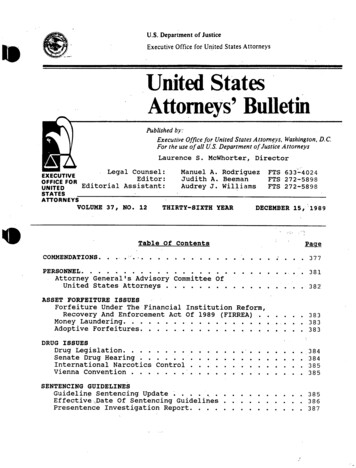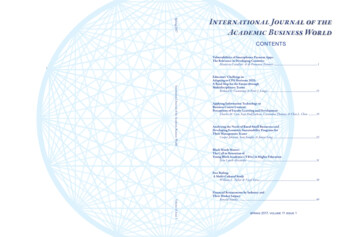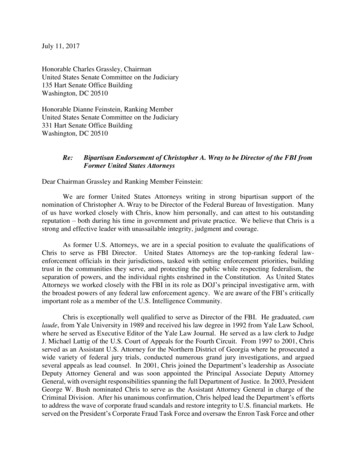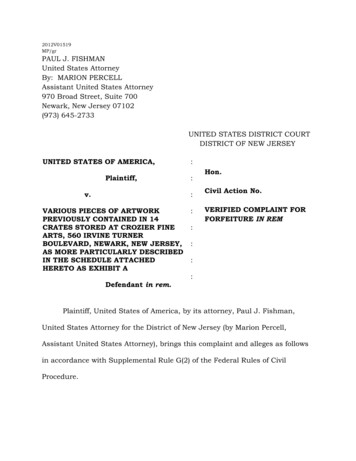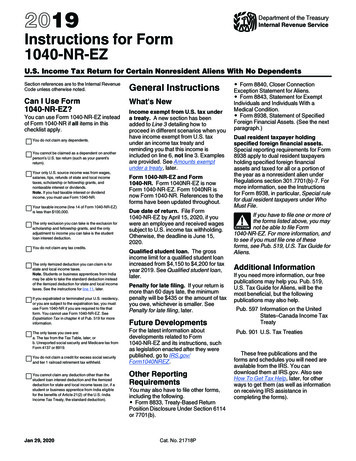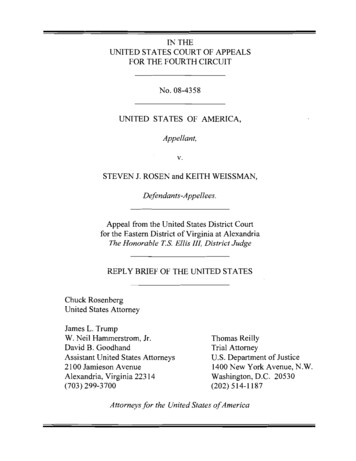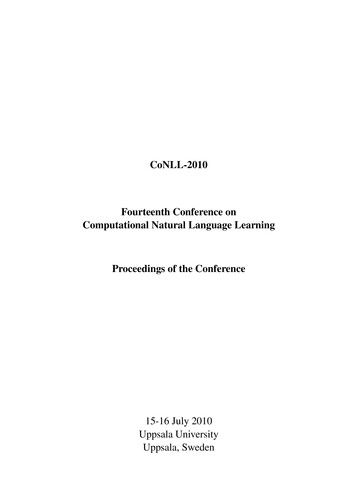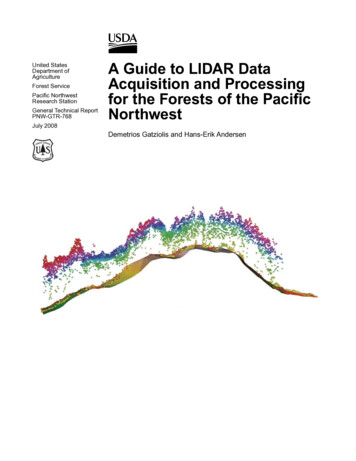
Transcription
United StatesDepartment ofAgricultureForest ServicePacific NorthwestResearch StationGeneral Technical ReportPNW-GTR-768July 2008A Guide to LIDAR DataAcquisition and Processingfor the Forests of the PacificNorthwestDemetrios Gatziolis and Hans-Erik Andersen
The Forest Service of the U.S. Department of Agriculture is dedicated to the principle ofmultiple use management of the Nation’s forest resources for sustained yields of wood,water, forage, wildlife, and recreation. Through forestry research, cooperation with theStates and private forest owners, and management of the National Forests and NationalGrasslands, it strives—as directed by Congress—to provide increasingly greater serviceto a growing Nation.The U.S. Department of Agriculture (USDA) prohibits discrimination in all its programs andactivities on the basis of race, color, national origin, age, disability, and where applicable,sex, marital status, familial status, parental status, religion, sexual orientation, geneticinformation, political beliefs, reprisal, or because all or part of an individual’s incomeis derived from any public assistance program. (Not all prohibited bases apply to allprograms.) Persons with disabilities who require alternative means for communication ofprogram information (Braille, large print, audiotape, etc.) should contact USDA’s TARGETCenter at (202) 720-2600 (voice and TDD). To file a complaint of discrimination, writeUSDA, Director, Office of Civil Rights, 1400 Independence Avenue, SW, Washington, DC20250-9410 or call (800) 795-3272 (voice) or (202) 720-6382 (TDD). USDA is an equalopportunity provider and employer.AuthorsDemetrios Gatziolis is a research forester, Forestry Sciences Laboratory, 620 SWMain, Suite 400, Portland, OR 97205; Hans-Erik Andersen is a research forester,Forestry Sciences laboratory, 3301 C St., Suite 200, Anchorage, AK 99503.
AbstractGatziolis, Demetrios; Andersen, Hans-Erik. 2008. A guide to LIDAR dataacquisition and processing for the forests of the Pacific Northwest. Gen. Tech.Rep. PNW-GTR-768. Portland, OR: U.S. Department of Agriculture, ForestService, Pacific Northwest Research Station. 32 p.Light detection and ranging (LIDAR) is an emerging remote-sensing technologywith promising potential to assist in mapping, monitoring, and assessment of forest resources. Continuous technological advancement and substantial reductionsin data acquisition cost have enabled acquisition of laser data over entire statesand regions. These developments have triggered an explosion of interest in LIDARtechnology. Despite a growing body of peer-reviewed literature documenting themerits of LIDAR for forest assessment, management, and planning, there seems tobe little information describing in detail the acquisition, quality assessment, andprocessing of laser data for forestry applications. This report addresses this information deficit by providing a foundational knowledge base containing answers tothe most frequently asked questions.Keywords: LIDAR, Pacific Northwest, FIA, forest inventory, laser, absoluteand relative accuracy, precision, registration, stand penetration, DEM, canopysurface, resolution, data storage, data quality assessment, topography, scanning.
Contents1Introduction1LIDAR Systems2System Specifications7Data Attributes9Data Storage11Data Acquisition Considerations16Data Quality Control17Return Coordinates21Spatial Completeness25Consistency of Tabular Return Attributes29PNW-FIA Software for Quality Assessment of LIDAR Data31References
A Guide to LIDAR Data Acquisition and Processing for the Forests of the Pacific NorthwestIntroductionLight detection and ranging (LIDAR), also known as airborne laser scanning(ALS), is an emerging remote sensing technology with promising potential toassisting mapping, monitoring, and assessment of forest resources. Compared totraditional analog or digital passive optical remote sensing, LIDAR offers tangibleadvantages, including nearly perfect registration of spatially distributed dataand the ability to penetrate the vertical profile of a forest canopy and quantify itsstructure. LIDAR has been used in many parts of the world to successfully assessheight and size of individual trees or, at the stand level, to estimate canopy closure,volume, and biomass of forest stands; to assess wildlife habitat; and to quantifystand susceptibility to fire (Andersen et al. 2005, Hinsley et al. 2006, Means et al.2000, Naesset 2002, Persson et al. 2002, Popescu and Zhao 2007). Continuoustechnological advancement and competition among vendors in the United Stateshave resulted in substantial reductions in data acquisition cost and have enabledacquisition of spatially complete laser data over entire states and regions. The U.S.Geological Survey has recently announced a plan to coordinate the acquisition ofLIDAR data at a national scale (Stoker et al. 2007). Laser scanning data are regularly acquired over several national forests in Western States. These developmentshave triggered an explosion of interest in LIDAR technology. Despite a growingbody of peer-reviewed literature documenting the merits of LIDAR for forestassessment, management, and planning, there seems to be a void in informationdescribing issues related to the acquisition and processing of laser data. In the pastyear alone, the authors have received numerous requests for guidance on the technical specifications of planned data acquisitions, on instructions on how to performdata quality assessment, and on whether scanning data can be used to meet specificobjectives. This article addresses this information deficit by providing a foundational knowledge base containing answers to the most frequently asked questions.LIDAR SystemsA LIDAR system operating from an airborne platform comprises a set of instruments: the laser device; an inertial navigational measurement unit (IMU), whichcontinuously records the aircraft’s attitude vectors (orientation); a high-precisionairborne global positioning system (GPS) unit, which records the three-dimensionalposition of the aircraft; and a computer interface that manages communicationamong devices and data storage. The system also requires that a GPS base stationinstalled at a known location on the ground and in the vicinity (within 50 km) of theaircraft, operate simultaneously in order to differentially correct, and thus improvethe precision of, the airborne GPS data.LIDAR offers nearlyperfect registration ofspatially distributeddata and the ability topenetrate the verticalprofile of a forestcanopy.A LIDAR systemcomprises thelaser device, aninertial navigationalmeasurement unit, ahigh-precision airborneglobal positioningsystem, and acomputer interface.
GENERAL TECHNICAL REPORT PNW-GTR-768The laser device emits pulses (or beams) of light to determine the range to a distanttarget. The distance to the target is determined by precisely measuring the timedelay between the emission of the pulse and the detection of the reflected (backscattered) signal. In topographic mapping and forestry applications, the wavelengthof the pulses is in the near-infrared part of the spectrum, typically between 1040and 1065 nm. There are two types of LIDAR acquisition differentiated by howbackscattered laser energy is quantified and recorded by the system’s receiver. Withwaveform LIDAR, the energy reflected back to the sensor is recorded as a (nearly)continuous signal. With discrete-return, small-footprint LIDAR, reflected energyis quantized at amplitude intervals and is recorded at precisely referenced pointsin time and space. Popular alternatives to the term “point” include “return” and“echo.” The energy amplitude pertaining to each return is known as intensity. Thisarticle addresses only small-footprint, discrete-return LIDAR.System SpecificationsLIDAR systems have been evolving for more than a decade, and will likelycontinue to evolve even faster in the years to come. Hence, when planning dataacquisition, it is essential to obtain specifications of currently available systems.Such specifications will determine both data acquisition costs and, quite likely, thefeasibility of projects the acquired data are expected to support. Baltsavias (1999a)provided a good (if somewhat out-of-date) overview of the basic engineering andgeometric concepts underlying airborne laser scanning, and Baltsavias (1999b)illustrated the variability in specifications among commercial systems. The majoroperational specifications of a LIDAR system are outlined below: Scanning frequency is the number of pulses or beams emitted by the laserinstrument in 1 second. Older instruments emitted a few thousand pulsesper second. Modern systems support frequencies of up to 167 kHz (167,000pulses per second). Sometimes they can be operated at lower-than-maximum frequencies, typically 100 kHz or 71 kHz, but seldom at low frequencies, say, 10 kHz. The scanning frequency is directly related to the densityof discrete returns obtained. Thus a system operating at 150 kHz onboardan aircraft flying at constant speed at a standard height above a target willgenerate a much higher number of returns than when operating at 71 kHz.Equivalently, a high-frequency system can generate desired return densitiesby operating on an aircraft that flies higher and faster than an aircraft carrying a lower frequency system, thereby reducing flying time and acquisition costs.
A Guide to LIDAR Data Acquisition and Processing for the Forests of the Pacific Northwest Scanning pattern is the spatial arrangement of pulse returns that wouldbe expected from a flat surface and depends on the mechanism used todirect pulses across the flight line. Of the four scanning patterns supportedby instruments used in acquiring laser data for forestry applications, theseesaw pattern (fig. 1a) and its stabilized equivalent (fig. 1b) are the mostcommon. In these two patterns, the pulse is directed across the scanningswath by an oscillating mirror, and returns are continuously generatedin both directions of the scan. Although this configuration is designedto preserve the spacing between returns, in practice, pulse density is notuniform and returns tend to “bunch up” at the end of the swath because ofmirror deceleration. The nonuniform spacing of returns can be partiallyFigure 1—Nadir view of theoretical scanning patterns of LIDAR instruments.
GENERAL TECHNICAL REPORT PNW-GTR-768 mitigated, but not eliminated, with the use of galvanometers. In the parallelline pattern (fig. 1c), a rotating polygonal mirror directs pulses alongparallel lines across the swath, and data are generated in one direction ofthe scan only. The elliptical pattern (fig. 1d) is generated via a rotatingmirror that revolves about an axis perpendicular to the rotation plane.Beam divergence. Unlike a true laser system, the trajectories of photonsin a beam emitted from a LIDAR instrument deviate slightly from thebeam propagation line (axis) and form a narrow cone rather than the thincylinder typical of true laser systems. The term “beam divergence” refersto the increase in beam diameter that occurs as the distance between thelaser instrument and a plane that intersects the beam axis increases. Typicalbeam divergence settings range from 0.1 to 1.0 millirad. At 0.3 millirad,the diameter of the beam at a distance of 1000 m from the instrument isapproximately 30 cm (fig. 2). Because the total amount of pulse energyremains constant regardless of the beam divergence, at a larger beamdivergence, the pulse energy is spread over a larger area, leading to a lowersignal-to-noise ratio.Scanning angle is the angle the beam axis is directed away from the“focal” plane of the LIDAR instrument (fig. 3) It should not be confusedFigure 2—Illustration of LIDAR beam divergence. Horizontal and vertical distances are drawn indifferent scales.
A Guide to LIDAR Data Acquisition and Processing for the Forests of the Pacific Northwest with the angle formed between the beam axis vector and a vertical plane(nadir view), because the latter angle is affected by the attitude of the aircraft. The maximum angle supported by most systems does not exceed 15degrees. The angle is recorded as positive toward the starboard and negative toward the port side of the aircraft. The combination of scanning angleand aboveground flight height determines the scanning swath (fig. 3).Footprint diameter is the diameter of a beam intercepted by a plane positioned perpendicularly to the beam axis at a distance from the instrumentequal to the nominal flight height (fig. 2). It is thus a function of both beamdivergence and the above-target flight height. The distribution of pulseenergy is not uniform over the extent of the footprint. It decreases radiallyfrom the center and can be approximated by a two-dimensional Gaussiandistribution.Figure 3—Illustration of scanning attributes of LIDAR data acquisition. Aircraft flying parallel to the ground and seesaw scanningpattern are assumed.
GENERAL TECHNICAL REPORT PNW-GTR-768 Pulse length is the duration of the pulse, in nanoseconds (ns). Along withdiscretization settings (below), it determines the range resolution of thepulse in multiple return systems, or the minimum distance between consecutive returns from a pulse.Number of returns (per beam/pulse) is the maximum number of individual returns that can be extracted from a single beam. Certain systems canidentify either the first or the first and last returns. Most modern systemscan identify multiple returns (e.g., up to five) from a single beam.Footprint spacing is the nominal distance between the centers of consecutive beams along and between the scanning lines (fig. 3), which, along withthe beam divergence, determines the spatial resolution of LIDAR data. Thefootprint spacing is a function of scanning frequency, the abovegroundflight height, and the velocity of the aircraft.Discretization settings are specifications integral to the processing of thebackscattered energy of a pulse to identify individual returns (fig. 4). Theyare system-specific and proprietary, and sometimes are referred to as digitization settings. They control the minimum energy amplitude necessaryto produce a return and, along with the pulse length, determine the minimal distance between consecutive returns (discretization tolerance) fromFigure 4—Illustration of the discretization process used to identify individualreturns by processing the backscatteredenergy of a laser pulse.
A Guide to LIDAR Data Acquisition and Processing for the Forests of the Pacific Northwestthe same pulse. Modern instruments can process the energy-backscatterpertaining to a single beam and identify up to six returns, but the majoritysupport only up to four. The optimal settings for forestry applications likelydepend on acquisition objectives and vegetation structure.Small-footprint LIDARdata comprise a set ofreturn coordinates inData Attributesthree dimensions withSmall-footprint LIDAR data comprise a set of return coordinates in three dimensions with each return usually carrying attribute values that relate either to thatreturn or to the pulse from which the return was generated. Pulse density is a direct function of the footprint spacing (described above)each return usually2 over a hypothetical flat plane: pulse density 1/(footprint spacing ). This isthe most consistent measure of the spatial resolution of a LIDAR data set.Return density is the most common term used in describing a data set,and is often confused with pulse density. It is the mean number of returnsin the data set present (in two dimensions) in a unit square area, typically1 m2. With the exception of single-return systems, return density is controlled by the specifications and operation mode of a LIDAR system and bythe target scanned. Assuming that all other specifications remain the same,the return density generated by a four-return-per-square-meter-capable system over a forest stand will be much higher than the density generated overa nearby pasture (fig. 5), because in the latter case, virtually all the energyreturned falls within a single quantum (distance class). Because of thisscene-dependent variability, users should specify a minimum pulse densityfor a given acquisition, instead of return density.Return intensity or simply intensity, is an attribute that describes thestrength of the beam backscattering pertaining to the return in question. Itdepends on the reflectance properties of the target, and hence it can potentially be used in target discrimination. Its utility for object classificationis often reduced because of its dependence on bidirectional reflectancedistribution function effects, the distance (range) to the laser instrument,the total number of returns identified in the parent beam, the rank of thereturn (first, second, etc.) in the parent beam, and the receiver’s gain factor.The latter term describes the scaling of the receiver’s sensitivity designedto prevent hardware damage in the event that it receives an extraordinarilyhigh amount of backscattered energy as can occur with high reflectivitytargets. Such reduction in sensor sensitivity is practically instantaneous. Thereverse scaling, an increase in sensitivity in the presence of continuouslyweak energy backscattering, usually takes several seconds. The presencecarrying attributevalues that relate eitherto that return or to thepulse from which thereturn was generated.
GENERAL TECHNICAL REPORT PNW-GTR-768of an isolated, single high-reflectivity target scanned in one flight line canthus lead to substantial discrepancy in the mean intensity of returns onthe overlapping part of two adjacent flight lines. Additional, object-independent variability in intensity values is introduced by suspected fluctuations inthe energy emitted by the laser instrument. Personal communication withscientists involved in LIDAR research have revealed that these fluctuationscan sometimes amount to 30 percent of the mean pulse energy and that theyare likely more pronounced for high-frequency systems. Although LIDARinstruments currently do not record gain factors and energy output levels,persistent user requests to enable their logging could facilitate intensity normalization in the future and thus improve intensity-based classification ofobjects. 1 Return intensity is recorded in 8 bits (values 1 to 255), 12 bits (1 to1023), and less often as a fraction in the 0 to 1 range or in 16 bits (1 to 65535).Figure 5—(a) False color (near infrared, red, green) digital aerial photograph and (b) corresponding gray-scale raster of LIDAR returns per square meter, with lighter tones depicting higher returncount.1Hyppä, J. Plenary session, 2007 International Society for Photogrammetry and RemoteSensing Workshop, Espoo, Finland.
A Guide to LIDAR Data Acquisition and Processing for the Forests of the Pacific Northwest Return number refers to the rank of a return among those generated fromone beam. It is meaningful only for systems that support multiple returnsper beam. The return number should not be confused with the number ofreturns, a beam attribute.Attributes that a return inherits from its parent beam include the scanangle, usually recorded in degrees; the end-of-scan-line, a binary (true/false) attribute indicating whether the parent beam marked the edge of ascanning line; and those sometimes assigned at the data postprocessingphase such as indices to flight lines or classification schemes, and GPStime, an indication of the precise time that a pulse was emitted. Providedsufficient precision is used for storing GPS time, this attribute can be usedas a unique identifier for a pulse.Additional information is usually organized in the form of metadata, and oftencontains spatial geographic information system (GIS) layers with the spatial extentof the data acquisition, flight lines, the date and time range, the model and characteristics of the LIDAR instrument, etc.Data StorageThe LIDAR data files are very large and can quickly fill up computer hard drives.The need for efficient access to and storage of scan data, coupled with the absenceof a universal format standard, has led developers of LIDAR software to implementtheir own, proprietary storage format, which, with few exceptions, pay little attention to enabling import/export options. Only recently a file format (LAS) endorsedby the American Society for Photogrammetry and Remote Sensing (ASPRS) hasbeen gaining popularity and support. As revealed in personal communications withseveral LIDAR data vendors across the United States in the last 2 years, the lack ofsignificant progress in format standardization has prompted data delivery requestsin ASCII (text) format in more than two-thirds of all acquisitions. Data deliveredin most of those acquisitions consisted of X, Y, and Z coordinates and intensityonly. This preference for the text format is rooted in the fact that, unlike any binaryalternative, the contents of text files are easily accessible via a text editor. Assumingdelimited format (text, space, tab, etc.) and that each file line carries data for onereturn, the data can be easily imported into popular databases and subsequentlyqueried, merged, grouped into subsets, and rearranged as needed.However, ASCII text is a poor format choice from the standpoint of data storageefficiency. To illustrate this issue, consider a LIDAR data file comprising a modest1 million returns with coordinates of two-digit (centimeter) precision (universaltransverse mercator projection) and 8- bit intensity being the only return attribute.
GENERAL TECHNICAL REPORT PNW-GTR-768Efficiency in accessingfiles is important inresearch efforts andin applications thatrequire files to be readmultiple times.The size of this file will be approximately 32,134,000 bytes in text format and only14,000,024 bytes in binary format (24 bytes are used to describe a transformationof scale in return coordinates from a two-decimal real number to a long integer),a gain in storage efficiency by a factor of 2.3. If the same file were to include alldata attributes mentioned in the previous section, its size in text format would beapproximately 64,094,000 bytes, and in LAS binary format it would be 28,000,227,a storage efficiency gain of also 2.3. In either file configuration (intensity only vs.all attributes), the time required for reading from or writing to the file in text formatwould be, depending on the hardware configuration of the computer, nearly anorder of magnitude longer than for binary format. Efficiency in accessing files isimportant in research efforts and in applications that require files to be read multiple times.A less-evident implication of the file format is realized when considering howLIDAR data are organized in individual files. A LIDAR data file would typicallycontain returns either from a rectangular portion of the acquisition area, sometimesreferred to as “bin” or “tile,” or from individual flight lines (fig. 6). Comparedto files representing smaller bins, files corresponding to larger ones will have asmaller percentage of returns near the borders of the bin, and thus introduce fewerFigure 6—Illustration of the spatial extent of datain LIDAR files. Shaded, single-digit-numberedstripes correspond to individual LIDAR files withdata from one flight line. Odd- and even-numberedstripes are flown in opposite directions. Darkershading shows stripe overlap. Dash-outlined,two-digit-numbered rectangles correspond to filescontaining returns from multiple flight lines.10
A Guide to LIDAR Data Acquisition and Processing for the Forests of the Pacific Northwestdiscontinuities or artifacts in data derivatives and metrics calculated along the binborders. Assuming an interest in minimizing border effects, maximum bin, andtherefore file, sizes should be targeted. Table 1 shows the limits in file size andcorresponding bin area imposed by a 32-bit computer operating system for variousdata storage formats and return density configurations. All data from an acquisitionwith a mere 100 million returns can be stored in just one binary file. If, instead, textformat is preferred, the data would have to be split into two or more files. Note thatswitching from a 32- to a 64-bit operating system would eliminate this issue, as thefile size supported by 64-bit operating systems is practically unlimited.Data acquisitionplanning should bebased on a carefulevaluation of theproject objectives whileData Acquisition Considerationsconsidering potentialData acquisition planning should be based on a careful evaluation of the projectobjectives while considering potential limitations imposed by budget constraints,availability of LIDAR instruments with specific capabilities, terrain, and vegetationstructure and phenology. Often, acquisition planning is challenging, as it involvesmany decisions among equally appealing or contrasting tradeoffs. The discussionbelow provides a synthesis of LIDAR data analysis objectives and their relation tosystem specifications and acquisition parameters.limitations imposedby budget constraints,availability of LIDARinstruments withspecific capabilities,terrain, and vegetationstructure andphenology.Table 1—Attributes of a single LIDAR data tTextBinaryTextBinaryAnyX, Y, Z, intensityX, Y, Z, intensityAllAllAny64-bitNumber ofreturnsDensity (returns /m 2)148- - - - Bin area (ha) - - - ,917Practically unlimitedNote: Text format assumes universal transverse mercator coordinates with 2-digit precision and 8-bit intensity.Quantification of forest structure and assessment of tree height and volume viaLIDAR data is typically performed either at the individual tree or plot/stand level.There is general agreement among researchers that the identification of individualtrees requires a minimal return density of approximately four returns per squaremeter. This density often implicitly assumes systems that support multiple returnsper pulse. High-scanning-frequency systems can achieve this density when usingaircraft that fly high and fast to reduce acquisition costs. However, two data setswith equal return density acquired over the same area by instruments operatingat different scanning frequencies can have very different return distributions in11
GENERAL TECHNICAL REPORT PNW-GTR-768three dimensions. This is in part because the energy carried by a single pulse inhigh-scanning-frequency systems, and therefore its ability to penetrate vegetation,is much lower than the energy of a pulse in a slower system. The high-scanningfrequency system should be expected to generate proportionally more returns fromthe upper part of the canopy. Conversely, the low-scanning-frequency system willlikely have a higher proportion of returns from the understory or the ground. Inforest stands with tall and very dense vegetation, common in the Pacific Northwest(PNW), it is likely that a lower frequency system could generate more groundreturns than a faster system, even where the overall density of the faster systemis much greater than the density generated by the slower system. Although theseassumptions have not been tested formally, they are indirectly supported by thefact that the proportion of ground-to-total returns generated by low-frequency lasersystems mounted on low-flying aircraft or helicopters over high-density tropicalforests (Clark et al. 2004) is much higher than the one achieved over comparablydense PNW forests scanned by high-frequency systems flying approximately 1000meters above terrain (Gatziolis 2007). Hence, where a precise and accurate description of the ground surface under dense vegetation is important, the option of using alower scanning frequency setting should be seriously considered.Although the three-dimensional distribution of returns is also affected bythe discretization process, the absence of specific information on the settings ofalternative systems usually precludes a meaningful evaluation of comparativeadvantages offered by each system. Fine sensitivity in pulse discretization, that is toset the minimum that the amplitude of the backscattered pulse energy would needto exceed for a return to be identified to a low value (fig. 4), will tend to producereturns closer to the top of the canopy and support a more detailed description ofvegetation surfaces, including leader stems typical of many conifer species. Finesensitivity, though, is associated with lower positional precision of returns fromlower vegetation strata. Fine distance tolerances between consecutive returns froma given beam would tend to produce more returns from the upper layers of tall,dense, and healthy vegetation at the expense of fewer returns from the ground.Coarse distance tolerances would prevent ground returns where the magnitude ofthe tolerance exceeds the mean vegetation height.As stated in the “Data Attributes” section, the local return density would differamong vegetation types and structures. To avoid misunderstandings, data acquisition requests should specifically mention the minimum pulse density (not returndensity) that is acceptable over a particular forest or land type. Data vendors withexperience in local acquisitions will likely be able to assess the flight height above12
A Guide to LIDAR Data Acquisition and Processing for the Forests of the Pacific Northwestground and aircraft speed for which their laser instrument can meet the requestedpulse density over a forest type of interest.To determine the preferred beam divergence setting (wide vs. narrow), oneshould consider how this setting affects the interaction of the beam with vegetation.In wide divergence, the canopy volume illuminated (or sampled) by the beam islarger than in narrow divergence. The ratio of canopy volume “sampled” by eachsetting is actually the square of the divergence ratio (tab
Authors Demetrios Gatziolis is a research forester, Forestry Sciences Laboratory, 620 SW Main, Suite 400, Portland, OR 97205; Hans-Erik Andersen is a research forester, Forestry Sciences laboratory, 3301 C St., Suite 200, Anchorage, AK 99503. The Forest Service of the U.S. Department of Agriculture is dedicated to the principle of multiple use management of the Nation's forest resources for .




